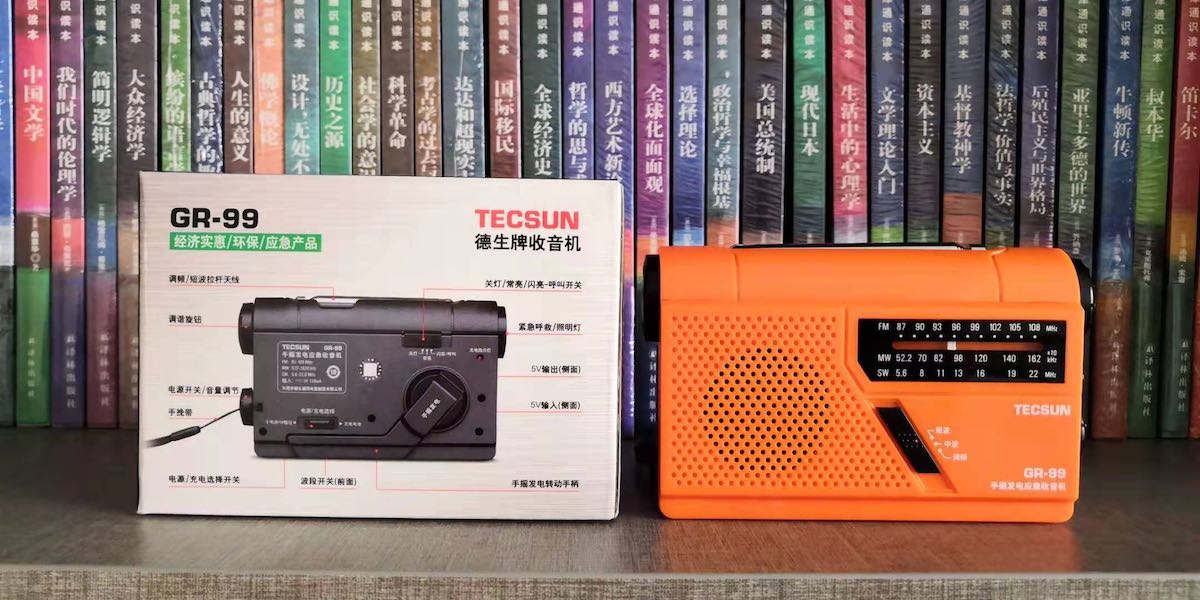
Many thanks to SWLing Post contributor, Mei Tao, who writes:
Hi Thomas:
I’m happy to tell you that yesterday [January 29, 2021] Tecsun released a new model Emergency Radio. I’ve included some photos:
The GR-99 includes FM, AM and SW bands. As most of today’s radios, it is also based on the DSP chip which offers good performance. It can be powered by the built-in Ni-MH battery and two AA batteries.
This radio also features hand crank power generator which can charge your device such as smartphone through the micro-USB cable. In case of emergency, GR-99 with flashlight and SOS alarm can give you a hand.
Nearly a month ago, I helped to test the prototype of this radio and gave them my advice. Now it’s great to see it on sale.
At last, provide you with a photo of me, almost two years ago. I took this selfie with my radios.
Oh I must admit that several radio in this photo were my friends’.
Sincerely
Mei Tao
Ha ha!!! I love the photo, Mei Tao–absolutely brilliant!
I’m happy to see that not only is Tecsun still producing an emergency radio with an analog dial (which requires less of the battery than a digital display), but also is still including the shortwave bands.
Thank you very much for reporting on this early production run Tecsun radios, Mei Tao!

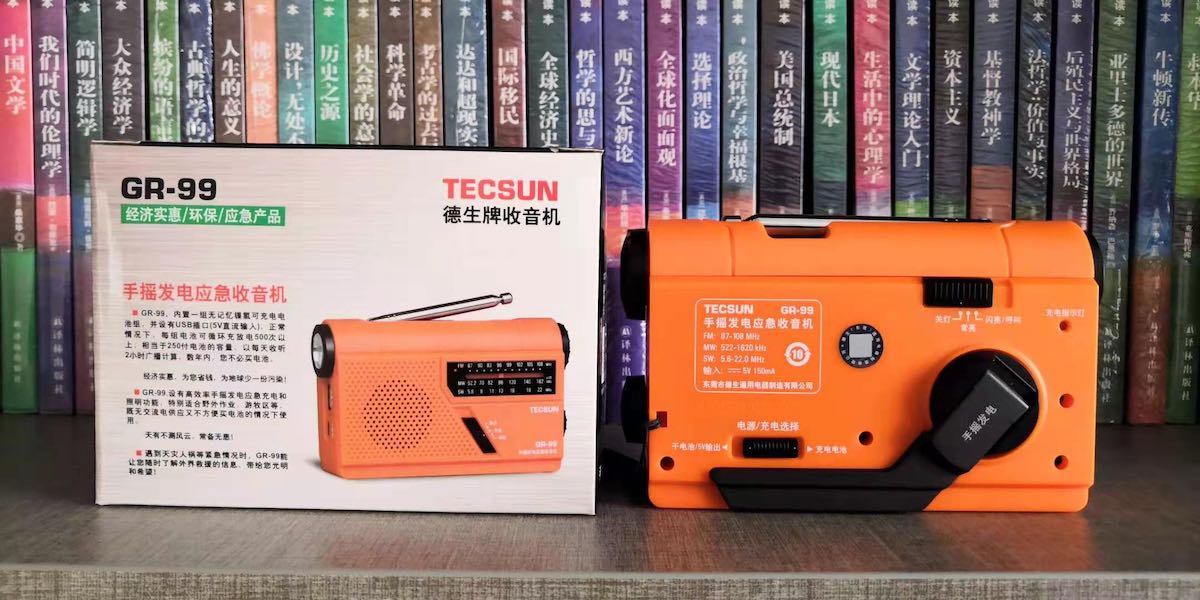
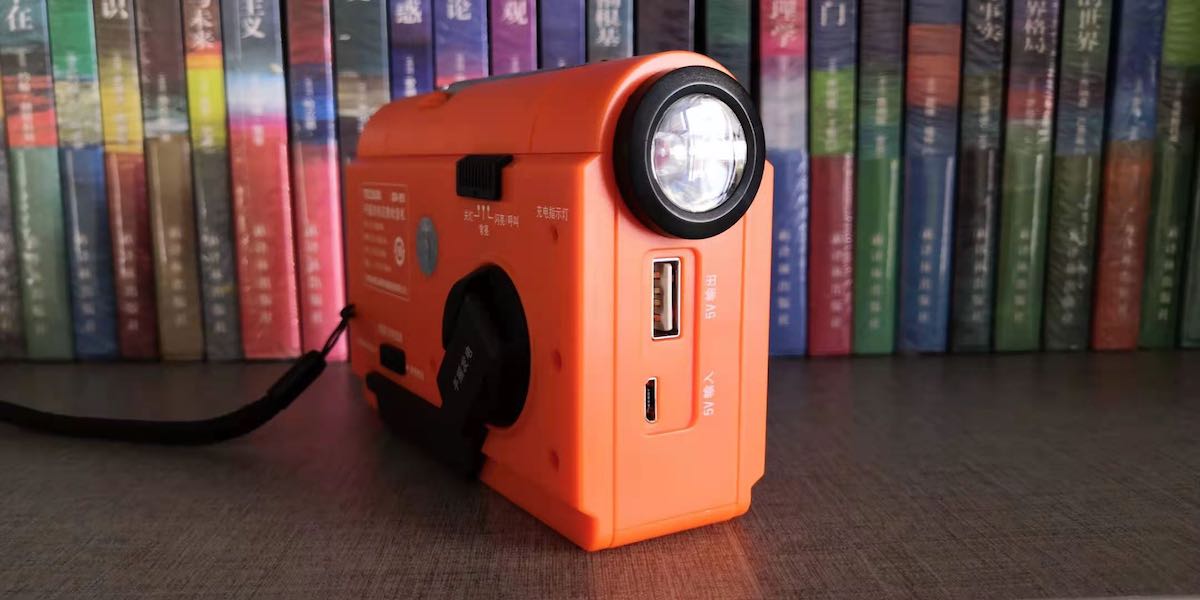
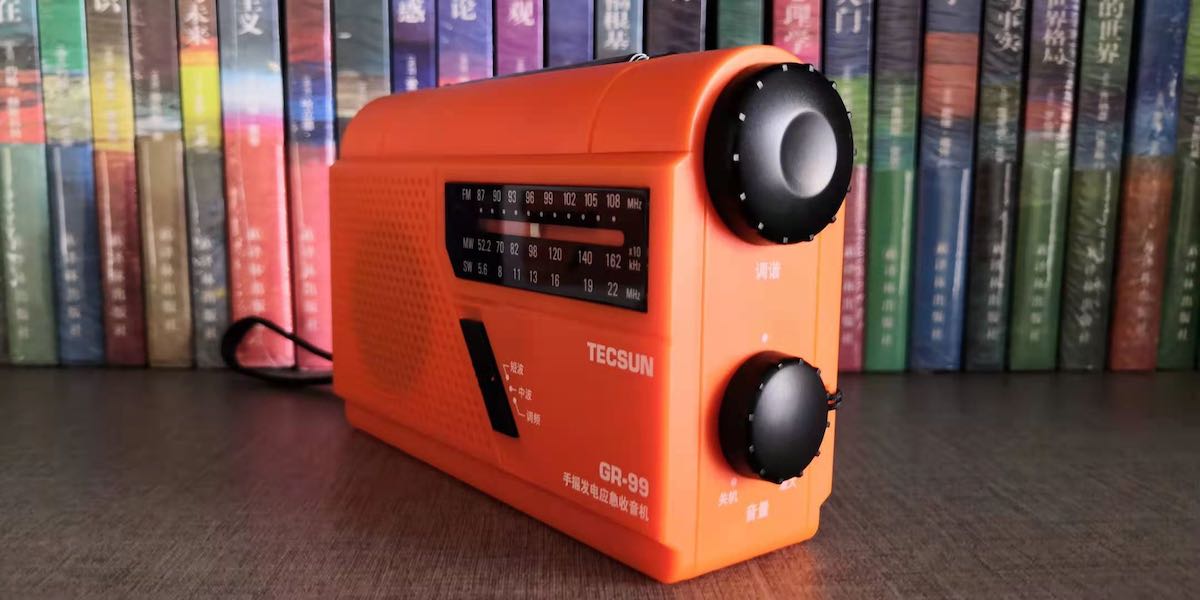
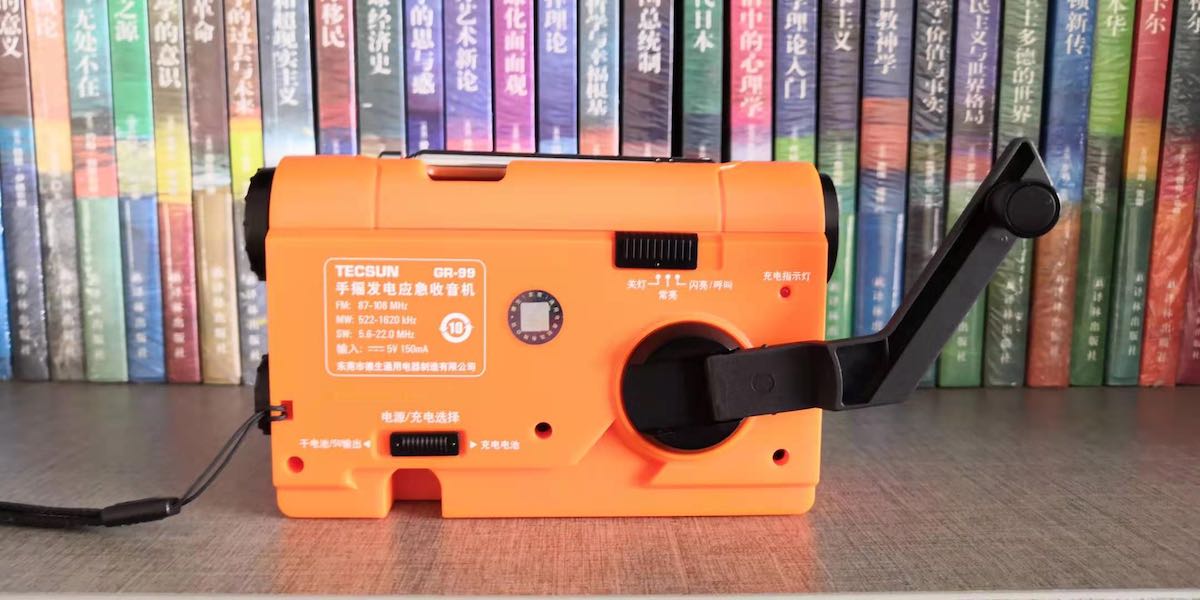
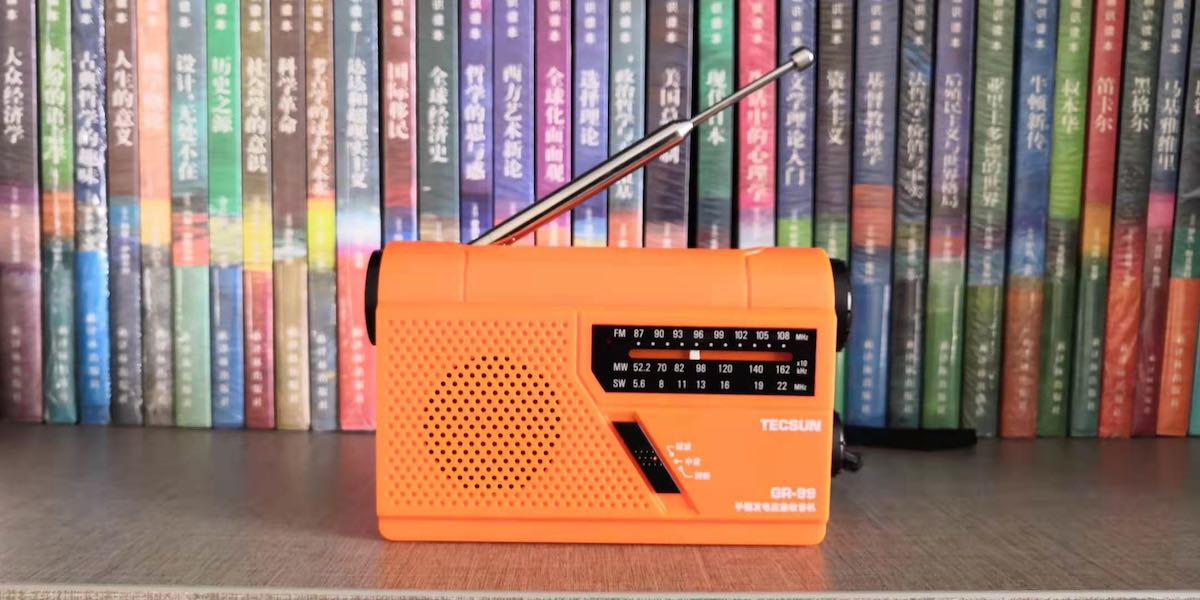
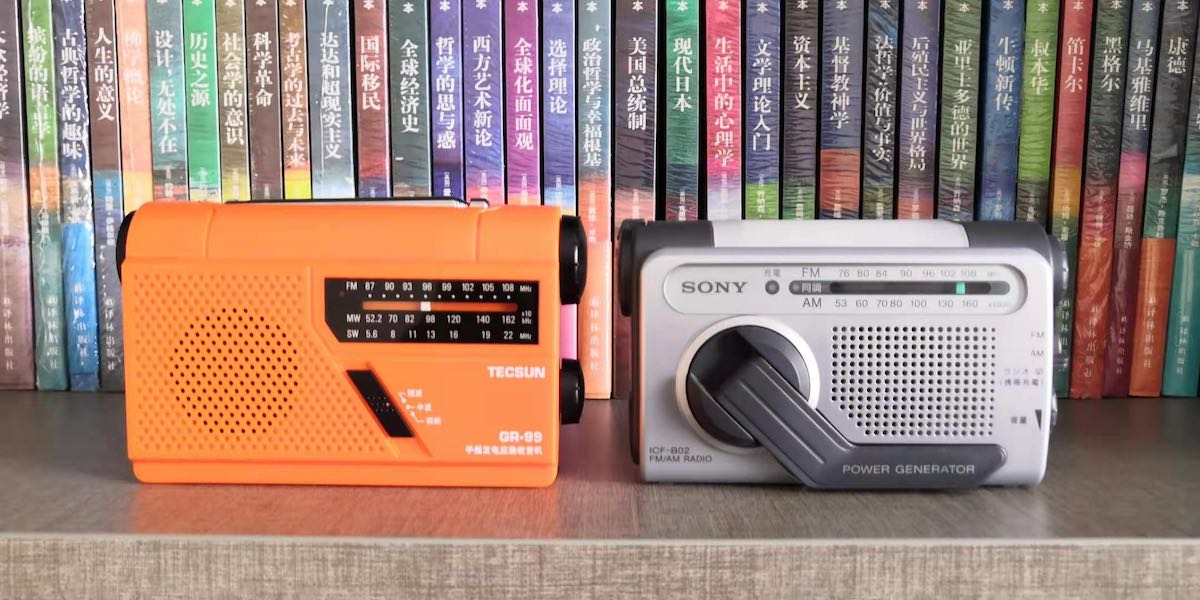

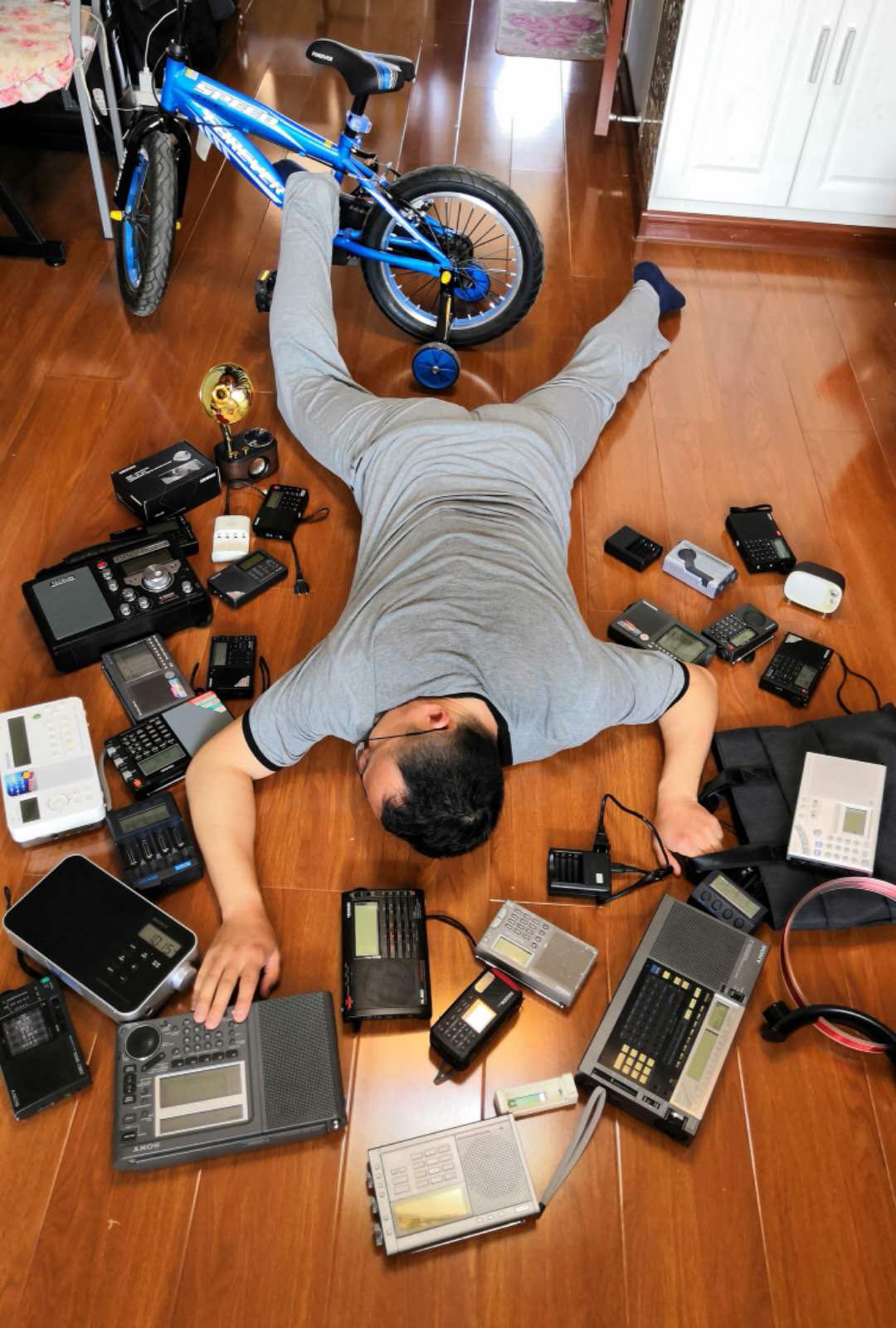
Merely a DSP clone of a Sony ICF-801, but with some minor variations, but the position of the Tuning/Vol and LED are identical, too bad the selectivity on AM is horrible, especially at this price point.
Maybe SW will perform better at night as I learned long ago that the only way to see if SW is coming in without a plethora of EMI is to go outside away from the interference provided by the internal wiring of a typical house.
I bought an Orange one, (GR-99) and it took less than 2 weeks to arrive from China.
Half-offtopic: anybody knows a source for hand crank power generators efficiency review or even better a comparison of the available models (built-in or standalone*)?
(* a la Metro 2033: https://metrovideogame.fandom.com/wiki/Universal_Charger)
The United States has outfitted approximately 77 radio stations with emergency facilities, spare transmitters, generators, fuel and supplies so that they can remain on the air for 60 days after a catastrophic event that disrupts normal services and communications. This is the National Public Warning System (NPWS) which may be identified on the air as the National Information Center. Good reason to keep an AM radio around for the foreseeable future.
I would think a DRM radio would require a lot of cranking to keep it powered.
Also, DRM audio often drops out when interference occurs, such as interference caused by static crashes during thunderstorms, tornadoes and hurricanes — emergency events.
The simplicity of an analog radio may be just the thing to keep it powered and to allow reception of vital content during emergencies.
I don’t see an earphone jack. These emergency radios tend not to have them. Decoding Shortwave Radiogram content would therefore require acoustic coupling.
Nice to see the 5.6 – 22 MHz shortwave coverage.
Kim,
When DAB started there was a campaign about the high power consumption of receivers. It turned out that the source of these emails was not in the reception area of DAB signals so who knows what the real figure would have been. Since then the DAB+ standard is now in widespread use, and the signal processing in DRM is almost identical except for the frequency of the transmissions and the bandwidth settings. Also most new receivers contain digital signal processing chips which has dropped the power consumption. In addition all new DAB+/DRM receivers use rechargeable lithium batteries. I notice that most do not complain about these batteries in mobile phones. Remember that you can get a plug which goes into the “cigarette lighter” socket in cars and will accept a USB charging cable.
As far as receiver drop outs goes, a comparison between DRM and AM in these conditions shows that DRM only drops out when the AM is unintelligible because DRM receivers convert the incoming signal down to almost audio frequencies and then a very sharp firmware filter eliminates all but the wanted signal. I do agree that a tuned circuit at the antenna input for the radio will be continued to be required to prevent strong signals at other frequencies causing problems.
In addition the slideshow and Journaline applications store error free data and the broadcasters repetitively broadcast that data. This clean data shows on the screen.
Lastly both DRM and DAB+ store the data which includes audio data prior to transmission and shuffle it. In DRM this can be up to 4 seconds worth. This spreads the distribution of errors. Foreword error correction data is then added, so that the errors caused by lightning can be detected in the receiver and corrected. In Southern India, there are 2 monsoons a year and lightning is prolific prior to the rain starting. There is now a network of very high powered medium frequency DRM transmitters which are all Emergency Warning Functionally capable.
I must agree with Kim that in real-word applications, over shortwave, DRM leaves something to be desired. It’s incredibly difficult with a benchmark receiver to achieve a steady lock on a DRM signal. It’s such a rare occurrence. Analog doesn’t have the features of DRM (Newsline, static free, etc), but it’s more reliable and intelligible over the air when a signal is marginal. Where you might hear fading on an AM analog signal, DRM drops out completely.
DRM is a brilliant mode in so many ways and looks great on paper, but in practice is an operation in frustration over HF. Using a portable HF DRM radio effectively is almost out of the question over HF. I’m sure it functions well in countries like India that plan to blanket the area with MW DRM transmitters.
Another goal with self-powered radios is to have as little current drain as possible to maximize battery life after using the hand-crank. DRM would require processing that would eat up self-charged batteries.
Hello Thomas,
while I cannot speak as someone possessing a DRM capable receiver – since my only experience has been using KiwiSDR connections – I agree that drop outs due to fading on HF seem to occur frequently unless there’s a booming signal. That said I’ve been impressed with how well some China Radio signals get here in South Australia having travelled a great distance, and there’s one hour of BBC programming daily on 15620 from Kranji (Singapore) which sometimes is also quite listenable. And for a signal that I think is aimed at South Asia, it also is quite good all things considered.
Thomas, There are no HF DRM signals aimed at the USA.
Radio Marti is transmitted on 7345 kHz from Greenville NC at Cuba using a directional antenna. The average power is only 5 kW 1700 – 0200 UTC.
Jerome, the Kranji (Singapore) are aimed at India at 100 kW (15620 kHz) for an hour a day.
Radio New Zealand Pacific is aimed at the South Pacific but sometimes is heard in the West Coast of the USA.
https://www.drmrx.org/forum/showthread.php?t=3001 contains many examples. Look for the file names ending in .wav, shows how good HF can sound. It comes from Brasilia in Brazil and received in Roswell, Georgia. 6730 km. Remember that this is a 1.12 kW transmitter aimed at the Amazon. 11910 kHz.
There are other examples are on youtube, search 11910 kHz Brasil DRM Exper and Brasil DRM tests
MONTENEGRO South Brazil, Gospell GR 216, digital radio – Listening All India Radio 7550 kHz DRM 14,400 km path 185 kW aimed on Southern Africa which kept going to Southern South America.
Yes, that’s correct about DRM signals not being aimed at the US. My point is that analog signals that are also not aimed at the US are so much easier to receive than DRM ones. By orders of magnitude, if I’m being frank. Sad, but true.
https://www.ee.co.za/article/digital-radio-drm-option-south-africa.html describes the trial to compare AM and DRM. The actual report is
http://www.drmsa.org/wp-content/uploads/2019/08/SEN_RFN_REP_MEASM_DRM30_RADIO_PULPIT_FINAL_REPORT_V1_04.pdf
The results are the the product of calculations in predictions and the performance is as the result of measurements comparing performance at measured field strengths.
“In addition all new DAB+/DRM receivers use rechargeable lithium batteries. I notice that most do not complain about these batteries in mobile phones.”
Because we don’t hand-crank our phones. The concern about power consumption isn’t so bad for radios which can recharge from the wall or car, but emergency radios have a hand crank in case that’s the method available for charging it. The type of battery is of little importance if the consumption makes it inefficient to listen by cranking.
That said, it’s not that hard to charge a radio using other means, even in a post-disaster situation, so long as the area is developed. Electricity is usually brought back online in a matter of days or weeks, and while it might be rationed, charging a radio battery isn’t expensive. The issue is of greater importance for areas without reliable access to power in the first place or without the capability to repair electricity infrastructure post disaster.
As for power consumption, I don’t know, or frankly care, about the DAB report and its problems. The portable receivers that currently exist for DRM are universally described as having poor battery life. That, on top of their high price and inconsistent quality, is one of the problems using it for emergency broadcasts. For India, where cars have receivers and the areas have blanket coverage, things may be different. Perhaps that market will lead to more availability of DRM receivers that don’t require an expensive automotive purchase, but I’d have expected them already. In the meantime, I expect DRM to have poor power efficiency on the receiver. If you wish to disprove this, you will have to cite actual numbers from actual receivers which efficiently receive and decode DRM. Since few exist outside of cars and externally-powered SDRs, I believe this will be difficult.
This radio is yet to appear on their manufacturers’ website. http://www.tecsun-radios.com/product/degen-de13-emergency-radio/ website. It also has a DSP chip.
Other than a dynamo and perhaps a lamp this is the only concession to being an emergency radio.
Digital Radio Mondiale has an Emergency Warning Functionality, which wakes the radio, then wakes the listener, makes a loud announcement from the emergency services, but also can display maps of the emergency area and Journaline can give upto 4,000 pages of indexed text which can be detailed instructions on how to survive. The messages can be in multiple languages including unusual fonts. Model CY-1 has an electronic screen, but does not look like a colour one to display images. A smart phone screen would be ideal for the above function.
Model GR88 appears to be aimed at the USA market, but it cannot respond to the Emergency Alert System which can operate in HD radio.
Even FM radio’s Radio Data System can display a line of scrolling text that can be used for emergency messages. There is no mention of this.
The Digital Signal Processing Chip should be able to be programmed to decode DRM and HD if Tecsun will pay xperi for the rights to use the HDradio system.
> “The Digital Signal Processing Chip should be able to be programmed to decode DRM …”
I’ve noticed this is a claim you state quite often, Al, without any reference to or basis in fact. Sure, if they were using a reasonably powerful general-purpose DSP processor, it *may* be possible – but the Silicon Labs Si47xx DSP chips typically used in these radios simply don’t have the processing power to do it, or the memory to store the the code if they did.
About the most complex digital signal processing they can do well is SSB; they fall down even when asked to do even the little added complication of synchronous detection. These chips simply aren’t “able to be reprogrammed to decode DRM”, or even HDRadio – it’d require a complete re-design around a completely new & more powerful chipset.